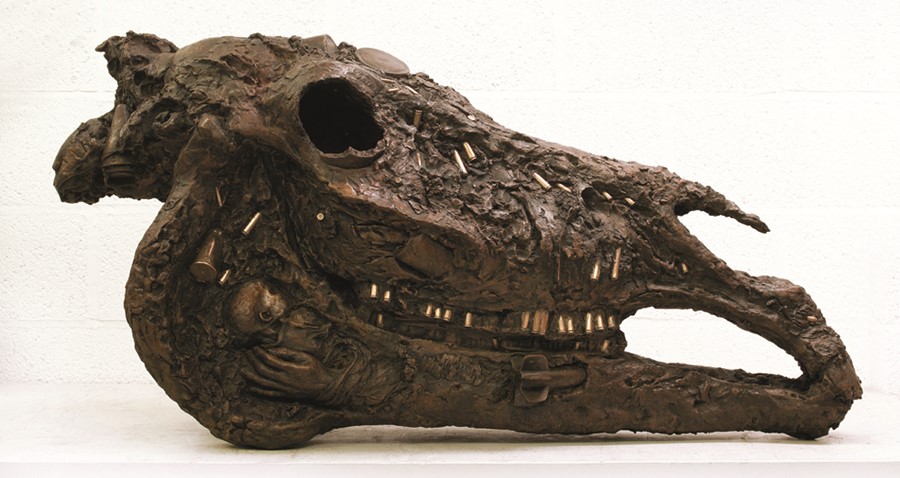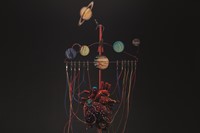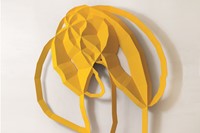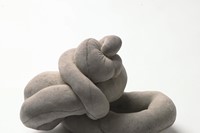Women Make Sculpture at Pangolin closes its doors this week, so the coming days are your last chance to see a group show by some of the most exciting female sculptors working today, both established and emerging.
Women Make Sculpture at Pangolin closes its doors this week, so the coming days are your last chance to see a group show by some of the most exciting female sculptors working today, both established and emerging. This diverse exhibition, featuring stuffed avian psychopomps, bullet-studded animal skulls and bizarre phallic bronze crabs residing in the shadow of a giant mountain of penises and coagulating bodily fluids, was dreamed up by Pangolin’s chief curator Polly Bielecka, who wanted to showcase the myriad forms of modern female sculptural practice – so often still overlooked by the mainstream art establishment. Although it is often said that we live in a post-feminist society, there are still very few female artists elevated to the level of our contemporary male ‘art stars’, despite the fact that the intake at art school is more-or-less equal in terms of gender. Here, we talk to Bielecka about the continuing marginalisation of female artists, the arguments surrounding the notion that all work is informed by gender and the continuing coruscating brilliance of Sarah Lucas.
Considering the vast discrepancy between the amount of male artists exhibited today and the amount of female artists exhibited, do you think any female artist can escape making work that deals in feminism?
I would agree with that notion, and a number of the artists were actually very worried about taking part in the show, because they didn’t want to be deemed to only have exhibited with other women to hold up that feminist banner – that’s why we went for such a neutral, but strong statement in the title. Obviously, feminism is going to be an aspect that’s inherent in putting a show together like this, but what we were aiming for was a celebration of the diversity of female sculptors – an opportunity they don’t often get because of the considerable marginalisation.
What are some of the most interesting art works in the show?
It’s impossible to single out any one in particular, but I think Dorothy Cross’s Family are very interesting pieces – the idea of a family group with the dominant male sporting a phallus on its back. Bryony Marshall’s piece is also particularly interesting to me because she’s come from a totally different background – she studied bio-chemistry at Oxford University before she went back to becoming a sculptor, and that’s definitely informed her work. She’s got a much more… well; perhaps you could consider it a more masculine approach.
Do you think some female artists feel like outsider artists, simply because their work is rarely exhibited or sold at the same level as men’s?
That is a really interesting dilemma. I don’t think you can make any generalisations about women’s art because it is just all so diverse. But coming from that slant, I suppose you could say that a number of the artists do feel like outsiders. It was interesting that on the panel we did with the artists it was split totally half-and-half between those who felt like gender had had an impact on their careers and those that felt that it absolutely hadn’t.
It’s also interesting to look at that notion of whether you can instinctively tell whether a piece of work is by a woman or a man. I don’t think it’s true per se at all but I think the first time I ever saw a Louise Bourgeois I knew it was by a woman…
That was certainly one of the aspects that we were interested in exploring, and judging by people’s responses to the show – and certainly having got to know the work very well during the show – that’s a very tenuous area. I don’t know if I feel any stronger that you can tell the difference – we’ve got aggressive work here; we’ve got war-inspired work here, and the abstract work that almost denies you a gender.
Would you say there are there certain things that a woman might put in her work that a male artist couldn’t comprehend...
I do think works like Rose Gibbs' Mountain, and possibly Collateral by Deborah van der Beek are works that – if you had given a brief to a male artist – would have been interpreted in a totally different way. But that’s not to say that they would be any worse, they would just be from a totally different angle. Rose’s piece has a satirical humour to it, which is obviously something that you wouldn’t associate with a traditional feminist art practice.
Did you have any fears that doing a women only show would further marginalize female artists, or at least serve to maintain a paradigm that sets them apart?
We did think very carefully before we did it because we didn’t want to be seen to be just playing off on simply doing a ‘gender show’, which is obviously a very easy route because it does appeal to a wide draw of people. Obviously, if we did a ‘male only show’ there would be uproar – but to be honest, we wouldn’t need to do a female only show if there wasn’t a difference in how people perceive them. That’s really what it all comes down to – trying to get artists exposure.
How important do you think Sarah Lucas’s work has been in changing the game in art for women?
I think it’s been hugely important and a lot of artists hugely respect her. She’s tackled gender and sex dead on in a more generalised way than perhaps Tracey Emin, for example. It feels less personal to me, and therefore I feel it’s broader ranging and more effective. Also, she’s still expanding and she’s still developing. The work we’ve got in the show is a beautiful work in progress, and it shows that she’s still very much continuing to be a leading light.
Do you think the work can genuinely escape being inherently informed by patriarchy?
I think probably all the artists have been affected by what is realistically probably still a patriarchal society, and I think what is fantastic about this show is that they have rebelled against that in the making – that they’ve consistently gone out and shown the technical ability of wielding heavy machinery is incredible. Almuth Tebbenhoff’s welded steel piece for example is absolutely stunning in its craftsmanship. So, in that sense, while they may have been subliminally informed, a lot of them have not necessarily let that take them over.
Women Make Sculpture is at at Pangolin London until 18 June 2011.



